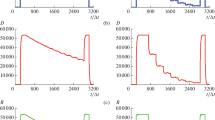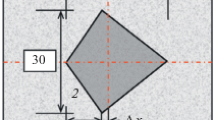Abstract
A mathematical model of the formation of high-energy digital radiographic images in conditions of low levels of digital signals has been developed. The model is designed to increase the efficiency of the analyzed systems in relation to the testing of large-sized objects by virtue of digital summation of images. Based on the model, an algorithm and a MathCad program designed to simulate digital images of test objects have been developed. Based on the analysis of the results of computational and field experiments, the principal possibility of increasing the efficiency of high-energy digital radiography systems based on accounting for rare events is illustrated.



Similar content being viewed by others
REFERENCES
Du Plessis, A., MacDonald, E., Waller, J.M., and Berto, F., Non-destructive testing of parts produced by laser powder bed fusion, Fundam. Laser Powder Bed Fusion Met., 2021, pp. 277–300. https://doi.org/10.1016/B978-0-12-824090-8.00016-0
Bossema, F.G., Domínguez-Delmás, M., Palenstijn, W.J., Kostenko, A., Dorscheid, J., Coban, S.B., Hermens, E., and Batenburg, K.J., A novel method for dendrochronology of large historical wooden objects using line trajectory X-ray tomography, Sci. Rep., 2021, vol. 11, no. 1, pp. 1–12. https://doi.org/10.1038/s41598-021-90135-4
Nyberg, J.V.E., MacGregor, D., Azaiez, F., Complementary methods: γ-beam techniques, X-ray fluorescence (XRF) and nuclear magnetic resonance (NMR), in Nuclear Physics for Cultural Heritage, Les Ulis: EDP Sci., 2021, pp. 37–53.
Karikh, V.P., Pevchenko, B.V., Kurbatov, A.V., Okhotnikov, A.A., and Skokov, A.A., Three-dimensional X-ray tomography of industrial objects with limited sizes of the recording screen, Russ. J. Nondestr. Test., 2021, vol. 57, no. 9, pp. 787–795. https://doi.org/10.1134/S1061830921090059
Ewert, U., Current developments in digital radiography and computed tomography from nm to macro scale, Proc. 12th Eur. Conf. Nondestr. Test. (ECNDT 2018) (Gothenburg, 2018), pp. 11–15.
Movafeghi, A., Mohammadzadeh, N., Yahaghi, E., Nekouei, J., Rostami, P., and Moradi, G., Defect detection of industrial radiography images of ammonia pipes by a sparse coding model, J. Nondestr. Eval., 2018, vol. 37, no. 1, pp. 1–7. https://doi.org/10.1007/s10921-017-0458-9
Kaczmarek, Ł., Kozłowska, A., Maksimczuk, M., and Wejrzanowski, T., The use of X-ray computed microtomography for graptolite detection in rock based on core internal structure visualization, Acta Geol. Pol., 2017, vol. 67, no. 2, pp. 299–306. https://doi.org/10.1515/agp-2017-0010
Udod, V.A., Osipov, S.P., and Wang, Y., Estimating the influence of quantum noises on the quality of material identification by the dual-energy method, Russ. J. Nondestr. Test., 2018, vol. 54, no. 8, pp. 585–600. https://doi.org/10.1134/S1061830918080077
Li, L., Li, R., Zhang, S., Zhao, T., and Chen, Z., A dynamic material discrimination algorithm for dual MV energy X-ray digital radiography, Appl. Radiat. Isotopes, 2016, vol. 114, pp. 188–195. https://doi.org/10.1016/j.apradiso.2016.05.018
Hall, C., Large-scale imaging on the Australian Synchrotron imaging and medical beamline (IMBL), Synchrotron Radiat. News, 2015, vol. 28, no. 5, pp. 24–29. https://doi.org/10.1080/08940886.2015.1080066
Osipov, S.P., Chakhlov, S.V., Kairalapov, D.U., and Sirot’yan, E.V., Numerical modeling of radiographic images as the basis for correctly designing digital radiography systems of large-sized objects, Russ. J. Nondestr. Test., 2019, vol. 55, no. 2, pp. 136–149. https://doi.org/10.1134/S1061830919020050
Busi, M., Kehl, C., Frisvad, J.R., and Olsen, U.L., Metal artifact reduction in spectral X-ray CT using spectral deep learning, J. Imaging, 2022, vol. 8, no. 3, p. 77. https://doi.org/10.3390/jimaging8030077
Zeng, G.L., Photon starvation artifact reduction by shift-variant processing, IEEE Access, 2022, vol. 10, pp. 13633–13649. https://doi.org/10.1109/ACCESS.2022.3142775
Morin, R.L. and Seibert, J.A., Considerations for selecting a digital radiography system, J. Am. Coll. Radiol., 2005, vol. 2, no. 3, pp. 287–290. https://doi.org/10.1016/j.jacr.2004.10.015
Zolkin, A.L., Munister, V.D., Bogaevskaya, O.Y., Yumashev, A.V., and Kornetov, A.N., Promising directions of information technologies applications for improving of control and measuring devices in medical industry, J. Phys. Conf. Ser., 2021, vol. 2094, no. 3, p. 032001. https://doi.org/10.1088/1742-6596/2094/3/032001
Andriole, K.P., Medical imaging modalities and digital images, in Practical Imaging Informatics, New York: Springer, 2021, pp. 25–39. https://doi.org/10.1007/978-1-0716-1756-4_3
Beckmann, M., Bhandari, A., and Krahmer, F., The modulo radon transform: theory, algorithms, and applications, SIAM J. Imaging Sci., 2022, vol. 15, no. 2, pp. 455–490. https://doi.org/10.1137/21M1424615
Osipov, S.P., Usachev, E.J., Chakhlov, S.V., Schetinkin, S.A., and Osipov, O.S., Inspection of bulk cargoes and liquids by the dual energy method, Radiat. Phys. Chem., 2020, vol. 177, p. 109133. https://doi.org/10.1016/j.radphyschem.2020.109133
Berger, M.J., Hubbell, J.H., Seltzer, S.M., Chang, J., Coursey, J.S., Sukumar, R., Zucker, D.S., and Olsen, K., XCOM: Photon cross sections database, NIST standard reference database 8 (XGAM). https://doi.org/10.18434/T48G6X
Petrushanskii, M.G. and Kornev, E.A., On determination of the effective energy of a mixed X-ray beam, Biomed. Eng., 2006, vol. 40, no. 2, pp. 102–105. https://doi.org/10.1007/s10527-006-0054-2
Zhang, D., Lai, W., Wu, J., Du, H., Zhao, R., and Fan, S., Establishment of ISO 4037-1 X-ray narrow-spectrum series, J. Eng., 2019, vol. 2019, no. 23, pp. 8858–8861. https://doi.org/10.1049/joe.2018.9126
Zav’yalkin, F.M. and Osipov, S.P., Dependence of the mean value and fluctuations of the absorbed energy on the scintillator dimensions, Sov. At. Energy, 1985, vol. 59, no. 4, pp. 842–846. https://doi.org/10.1007/BF01123317
Barbiero, A. and Ferrari, P.A., Simulation of correlated Poisson variables, Appl. Stochastic Models Bus. Ind., 2015, vol. 31, no. 5, pp. 669–680. https://doi.org/10.1002/asmb.2072
Zhao, N. and Chen, X., Exploring the integration of MathCad-assisted mathematics experiments into higher mathematics teaching, Comput.-Aided Des. Appl., 2022, vol. 19, no. S1, pp. 117–127. https://doi.org/10.14733/cadaps.2022.S1.117-127
Sarantites, D.G. and Sobotka, L.G., Computational templates for introductory nuclear science using MathCad, Am. J. Phys., 2013, vol. 81, no. 1, pp. 44–49. https://doi.org/10.1119/1.4764079
Chang, J., Soldatov, A., Sorokin, P., Kostina, M., Soldatov, A., Xu, S., and Chiriev, A., Gaussian filtered smallangle ultrasonic computed tomography using linear arrays, Progress Mater. Sci. Eng., 2021, pp. 29–38. https://doi.org/10.1007/978-3-030-68103-6_3
Kutsaev, S., Agustsson, R., Arodzero, A., Boucher, S., Hartzell, J., Murokh A., O’Shea, and Smirnov, A.Y., Electron accelerators for novel cargo inspection methods, Phys. Procedia, 2017, vol. 90, pp. 115–125. https://doi.org/10.1016/j.phpro.2017.09.036
Graham, C. and Talay, D., Strong law of large numbers and Monte Carlo methods, in Stochastic Simulation and Monte Carlo Methods, Berlin: Springer, 2013, pp. 13–35. https://doi.org/10.1007/978-3-642-39363-1_2
Kutsaev, S.V., Advanced technologies for applied particle accelerators and examples of their use, Techn. Phys., 2021, vol. 66, no. 2, pp. 161–195. https://doi.org/10.1134/S1063784221020158
Schiff, L.I., Nonlinear meson theory of nuclear forces. II. Nonlinearity in the meson-nucleon coupling, Phys. Rev., 1951, vol. 84, no. 1, pp. 252–253. https://doi.org/10.1103/PhysRev.84.10
Khasanov, S., Suleymanov, R., Safarov, A., Safarov, A., Tedila, H.M., and Muratov, R., Calculation of exposure and absorbed dose at irradiation samples by electron bremsstrahlung, Radiat. Phys. Chem., 2021, vol. 188, p. 109651. https://doi.org/10.1016/j.radphyschem.2021.109651
Scientific educational cargo vehicle inspection system. http://portal.tpu.ru/departments/laboratory/rknl/eng/ products/iDK. Cited April 27, 2022
ANSI N42.46. American national standard for determination of the imaging performance of X-ray and gamma-ray systems for cargo and vehicle security screening, 2008.
Osipov, S.P., Yadrenkin, I.G., Chakhlov, S.V., Osipov, O.S., and Usachev, E.Y., Simulation modeling in digital radiography with allowance for spatial outlines of test objects, Russ. J. Nondestr. Test., 2020, vol. 56, no. 8, pp. 647–660. https://doi.org/10.1134/S1061830920080082
Funding
The work was carried out with the financial support of the Ministry of Science and Higher Education of the Russian Federation within the framework of the State Task “Science,” project no. FSWW-2020-0014.
Author information
Authors and Affiliations
Corresponding authors
Rights and permissions
About this article
Cite this article
Zhvyrblya, V.Y., Osipov, S.P. & Sednev, D.A. Increasing Penetrating Power of Digital Radiography Systems Based on Analysis of Low-Intensity Signals. Russ J Nondestruct Test 58, 583–597 (2022). https://doi.org/10.1134/S1061830922070129
Received:
Revised:
Accepted:
Published:
Issue Date:
DOI: https://doi.org/10.1134/S1061830922070129




